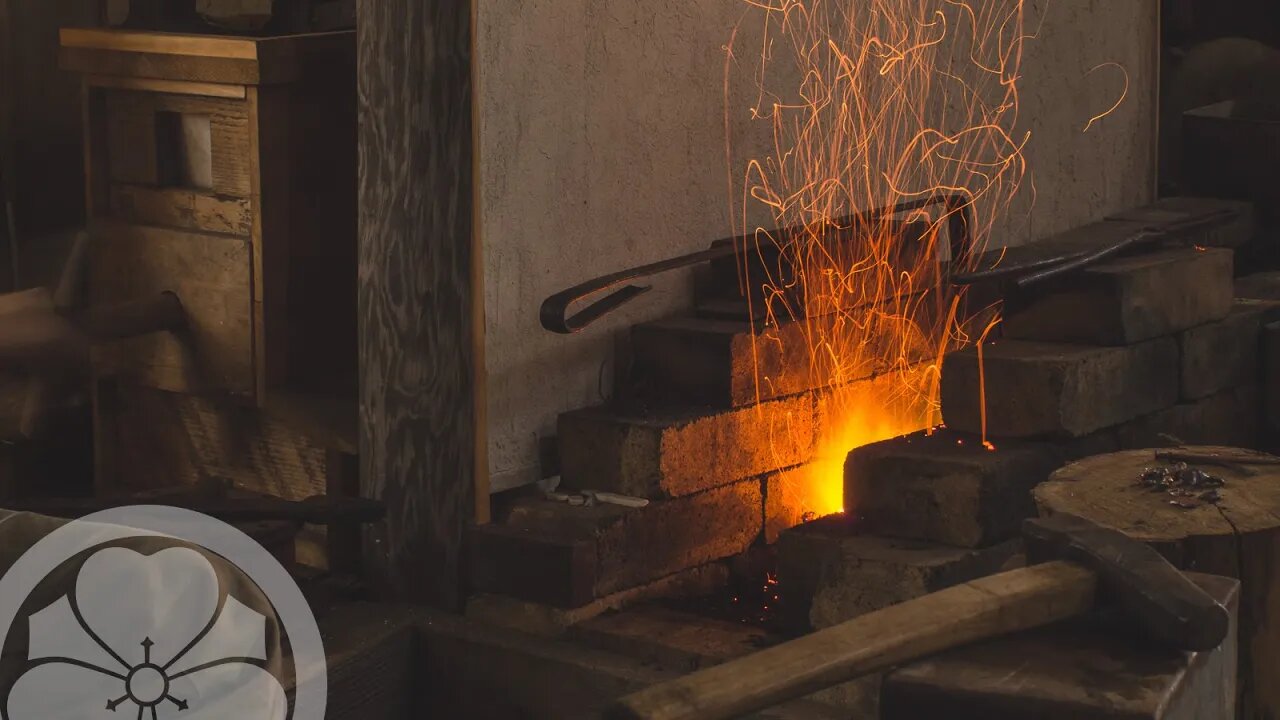Premium Only Content

TLDW #26 - Traditional Yaki-Ire, Hardening a Tanto
**WARNING: This is the longer process version intended for serious students of the forge. Traditional clay/charcoal/water yaki-ire, differential hardening a classical tanto style kotanto blade forged from reclaimed carbon steel. more on yaki-ire...
Process of Clay Tempering a Tanto Blade
http://islandblacksmith.ca/process/yaki-ire-clay-tempering/
Once the steel is shaped as much as possible in its softer state, it is coated with a thin layer of clay along the edge and a thicker layer on the body and spine. During the hardening process, the split second difference in cooling time caused by the clay layer creates two different hardness areas in the same piece of steel. The edge cools faster and forms a very hard steel structure called martensite while the body cools slower and forms a very tough steel structure made of ferrite and pearlite. The boundary between these two areas is called hamon and is commonly seen as a frosted wavy line down the length of a polished sword blade.
The clay is a mixture of approximately thirds of natural clay, crushed charcoal, and polishing stone powder. Each smith has their own recipe but the basics are the same...natural clay: to make it stick, polishing stone powder: to keep it from shrinking and cracking when it dries, and charcoal powder: to keep it from cracking when it is heated...knowing these properties allows a smith to make adjustments as needed.
The spine and body of the blade are coated with a thin layer of the clay mixture to insulate and slow down the cooling while the edge and tip are coated in a very thin slip layer which actually cools faster than bare steel and protects from oxidation while heating.
When the clay is fully dry, a charcoal fire is used to heat the steel slowly and evenly, taking care not to overheat any part of it and working in the dark for accurate colour viewing. First the spine is heated to bring the whole blade to just below temperature, and then it is flipped over to focus heat on the edge. When the entire edge is at the correct temperature, it is plunged into a hot water bath, edge down, and held until cool (yaki-ire). The tang is not heated or hardened and can be drilled later for the mekugi-ana. The hardness is checked with a file and the process repeated if necessary. After hardening, the clay is removed and the steel is heated slightly again to remove some of the internal stresses (yaki-modoshi). Once this process is finished, and if the steel survives, the blade is ready for Togi, shaping and hand polishing using waterstones.
-
 LIVE
LIVE
Nerdrotic
2 hours ago $0.70 earnedInvestigations Into Earth's Moon | Forbidden Frontier #110
444 watching -
 LIVE
LIVE
Quite Frankly
8 hours ago"The Unconscious Mind & Hypnosis" ft. Giulio Anselmo 8/7/25
491 watching -
 1:06:01
1:06:01
vivafrei
3 hours agoTrumps Crackdown on the Census! Corruption in Canada, Eh! Tulsi's Interview! Carville's Apology!
32.2K20 -
 15:32
15:32
AndresRestart
8 hours ago $0.11 earnedTHESE Mario 40th Anniversary Rumors Make Way More Sense Than That Collection "Leak"
6.39K1 -
 2:11:45
2:11:45
Redacted News
4 hours agoThis is HUGE news, and neo-cons are already trying to DESTROY it | Redacted News Live
113K83 -
 30:53
30:53
Kimberly Guilfoyle
6 hours agoThe Trump Doctrine Delivers, Interview with Daily Signal Producer Virginia Allen | Ep244
28.7K14 -
 1:03:56
1:03:56
Sarah Westall
4 hours agoBy Design or Organic? Profound Culture Change Oncoming and Accelerating w/ Dr. Drew
29.3K3 -
 30:00
30:00
BEK TV
22 hours agoCounter Culture Mom
3.93K -
![🔴LIVE - DR DISRESPECT - [DROPS ON] BATTLEFIELD 6 BETA LAUNCH DAY!](https://1a-1791.com/video/fww1/de/s8/1/E/W/g/9/EWg9y.0kob-small-LIVE-DR-DISRESPECT-DROPS-ON.jpg) 9:03:49
9:03:49
Dr Disrespect
10 hours ago🔴LIVE - DR DISRESPECT - [DROPS ON] BATTLEFIELD 6 BETA LAUNCH DAY!
132K15 -
 2:57:45
2:57:45
Barry Cunningham
7 hours agoMUST SEE: PRESIDENT TRUMP HOSTS PURPLE HEART CEREMONY | AND MORE NEWS!
35.3K23